Documentation
Duo Single Sign-On for Cisco Firepower with Secure Client
Last Updated: March 20th, 2025Contents
Add two-factor authentication and flexible security policies to Cisco Firepower with Secure Client SAML 2.0 logins with Duo Single Sign-On. Our cloud-hosted SSO identity provider offers inline user enrollment, self-service device management, and support for a variety of authentication methods — such as passkeys and security keys, Duo Push, or Verified Duo Push — in the Universal Prompt.
Overview
Duo's SAML SSO for Cisco Firepower (FTD) supports inline self-service enrollment and the Duo Prompt for Secure Client and web-based SSL VPN logins. This deployment option requires that you have a SAML 2.0 identity provider (IdP) in place that features Duo authentication, like Duo Single Sign-On. Primary and Duo secondary authentication occur at the identity provider, not at the Firepower itself.
These instructions walk you through adding SSO to your FTD using the Firepower Management Center (FMC) console. The instructions also assume you already have a functioning FTD Remote Access SSL VPN deployment using an existing AAA authentication server (like an on-premises AD/LDAP directory).
Minimum Supported FTD/FMC and Client Versions
Cisco Firepower SSO requires FTD/FMC version of 6.7.0 or higher, plus AnyConnect 4.6 or later or Secure Client. Prior versions of FTD/FMC and AnyConnect do not support SAML login or use a different browser experience. Add Duo protection to earlier Firepower versions with our Cisco Firepower RADIUS with AnyConnect configuration.
Trusted Endpoints Support
Be aware of these AnyConnect client minimum version requirements for Duo's Trusted Endpoints certificate detection.
| Operating System | AnyConnect Version |
|---|---|
| Windows | AnyConnect 4.7.04056 or later |
| macOS | AnyConnect 4.8.00175 or later |
| iOS | AnyConnect 4.8.00807 or later |
Trusted Endpoints detection which does not rely on certificates has no dependency on a specific client app version.
WebAuthn Support
The FTD SAML login experience supports use of Duo WebAuthn authentication methods like Touch ID and security keys for client logins under the following conditions:
- The device has been updated to Firepower 7.1.0 firmware or later.
- The RA VPN connection profile SAML Login Experience has Default OS Browser enabled.
- Access devices use AnyConnect 4.10.04065 or later or Secure Client.
- Duo Universal Prompt is enabled for the Duo SSO Cisco ASA integration as noted in the setup instructions in this document.
With all requirements in place, Firepower RA VPN SSO logins launch in the client's external browser instead of an embedded browser, allowing WebAuthn functionality in the Duo Universal Prompt. This also extends Duo Passwordless to client logins.
About Duo Single Sign-On
Duo Single Sign-On is our cloud-hosted SSO product which layers Duo's strong authentication and flexible policy engine on top of Cisco Firepower logins. Duo Single Sign-On acts as an identity provider (IdP), authenticating your users using existing on-premises Active Directory (AD) or another SSO IdP. Duo SSO prompts users for two-factor authentication and performs endpoint assessment and verification before permitting access to Cisco Firepower.
Duo Single Sign-On is available in Duo Premier, Duo Advantage, and Duo Essentials plans, which also include the ability to define policies that enforce unique controls for each individual SSO application. For example, you can require that Salesforce users complete two-factor authentication at every login, but only once every seven days when accessing Cisco Firepower. Duo checks the user, device, and network against an application's policy before allowing access to the application.
Configure Single Sign-On
Before configuring Cisco Firepower with Duo SSO using Security Assertion Markup Language (SAML) 2.0 authentication you'll first need to enable Duo Single Sign-On for your Duo account and configure a working authentication source.
Once you have your SSO authentication source working, continue to the next step of creating the Cisco Firepower application in Duo.
Create the Cisco Firepower Application in Duo
-
Log in to the Duo Admin Panel and navigate to Applications → Protect an Application.
-
Locate the entry for Cisco Firepower Threat Defense VPN with a protection type of "2FA with SSO hosted by Duo (Single Sign-On)" in the applications list. Click Protect to the far-right to start configuring Cisco Firepower Threat Defense VPN. See Protecting Applications for more information about protecting applications with Duo and additional application options. You'll need the information on the Cisco Firepower Threat Defense VPN page under Metadata later.
-
No users can log in to new applications until you grant access. Update the User access setting to grant access to this application to users in selected Duo groups, or to all users. Learn more about user access to applications. If you do not change this setting now, be sure to update it so that your test user has access before you test your setup.
Duo Universal Prompt
The Duo Universal Prompt provides a simplified and accessible Duo login experience for web-based applications, offering a redesigned visual interface with security and usability enhancements.
| Universal Prompt | Traditional Prompt |
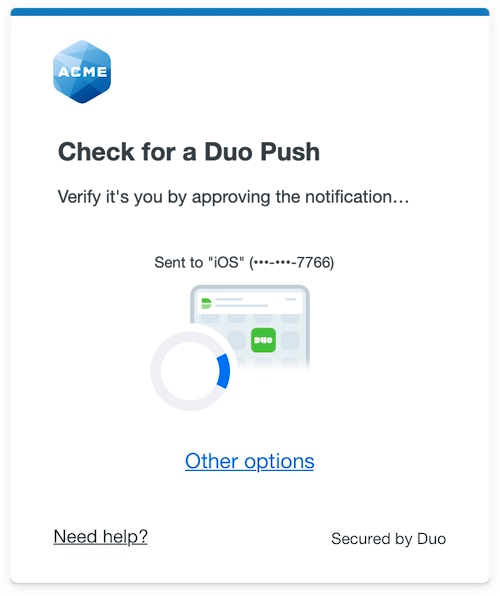 |
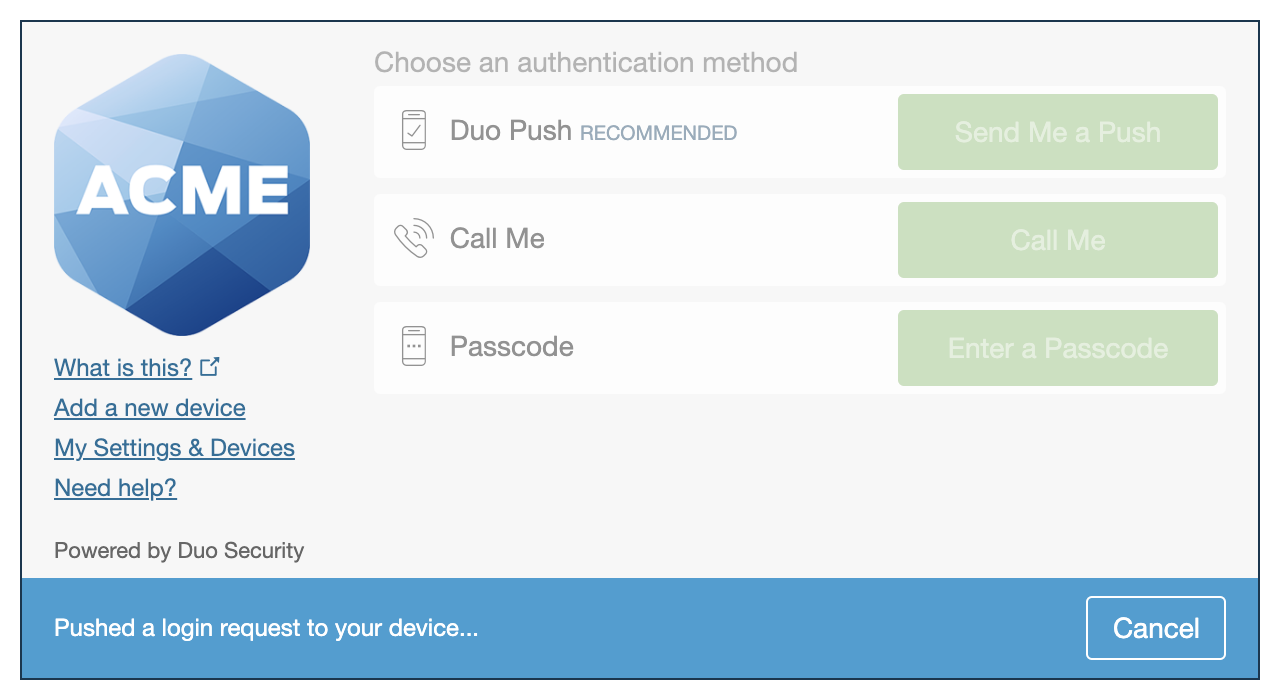 |
We've already updated the Duo Cisco Firepower Threat Defense VPN application hosted in Duo's service to support the Universal Prompt, so there's no action required on your part to update the application itself. If you created your Cisco Firepower Threat Defense VPN application before March 2024, you can activate the Universal Prompt experience for users from the Duo Admin Panel. Cisco Firepower Threat Defense VPN applications created after March 2024 have the Universal Prompt activated by default.
If you created your Cisco Firepower Threat Defense VPN application before March 2024, it's a good idea to read the Universal Prompt Update Guide for more information, about the update process and the new login experience for users, before you activate the Universal Prompt for your application.
Activate Universal Prompt
Activation of the Universal Prompt is a per-application change. Activating it for one application does not change the login experience for your other Duo applications.
The "Universal Prompt" area of the application details page shows that this application is "Ready to activate", with these activation control options:
- Show traditional prompt: Your users experience Duo's traditional prompt via redirect when logging in to this application.
- Show new Universal Prompt: (Default) Your users experience the Universal Prompt via redirect when logging in to this application.
The application's Universal Prompt status shows "Activation complete" here and on the Universal Prompt Update Progress report.
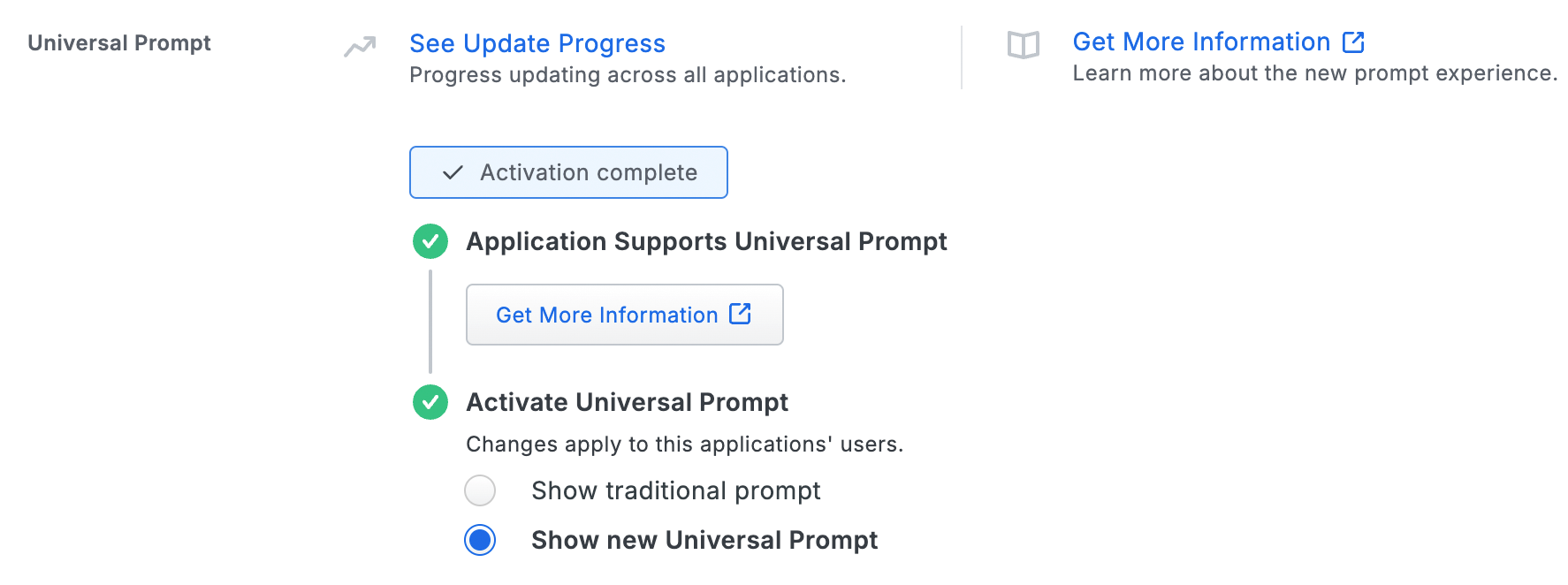
Should you ever want to roll back to the traditional prompt, you can return to this setting and change it back to Show traditional prompt. However, this will still deliver the Duo prompt via redirect, not in an iframe. Keep in mind that support for the traditional Duo prompt ended for the majority of applications in March 2024.
Universal Update Progress
Click the See Update Progress link to view the Universal Prompt Update Progress report. This report shows the update availability and migration progress for all your Duo applications. You can also activate the new prompt experience for multiple supported applications from the report page instead of visiting the individual details pages for each application.
Configure Cisco Firepower SSO
Add Duo Single Sign-On to Cisco Firepower as a new single sign-on provider. These instructions assume you're using FMC to configure FTD.
Upload Certificate
-
In the Duo Admin Panel under "Downloads", click Copy certificate.
-
Log into your Cisco FMC that manages your FTD you'd like to configure to use SSO.
-
Click on the Devices button at the top of the screen; from the drop-down click on Certificates.
-
On the "Certificates" page click the Add button in the top-right corner of the screen. A new window will pop-up.
-
On the "Add New Certificate" screen use the drop-down under Device to select the FTD where you're configuring SSO.
-
Under "Certificate Enrollment" click the + button. A new window will pop-up.
-
On the "Add Cert Enrollment" page type Duo_Single_SignOn or a memorable name into the Name field.
-
Under the "CA Information" tab select Manual from the Enrollment Type drop-down.
-
Check the box next to CA Only.
-
Paste the certificate file text that you previously copied, including the
-----BEGIN CERTIFICATE-----and-----END CERTIFICATE-----lines, into the CA Certificate field in FMC.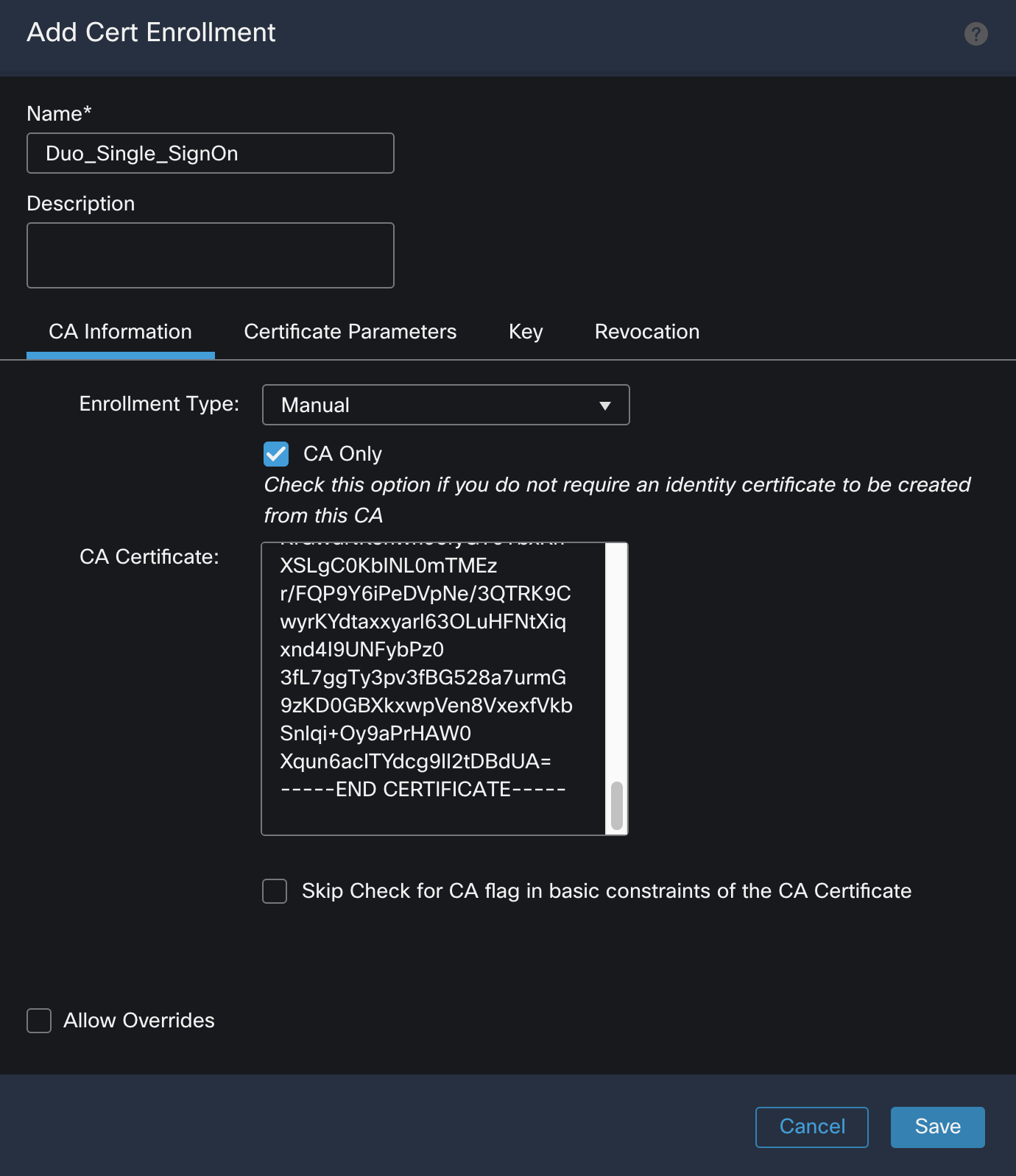
-
Click Save at the bottom of the window.
-
You'll return to the "Add New Certificate" window. Click Add.
Add a Single Sign-On Server
-
On the Cisco FMC page click on the Objects button at the top of the screen, from the drop-down click on Object Management.
-
On the left-hand navigation expand AAA Server and click on Single Sign-on Server.
-
Click the Add Single Sign-on Server button in the upper-right hand corner of the page. A new window will pop-up.
-
In the Name field type Duo_Single_SignOn or a memorable name.
-
Copy the Identity Provider Entity ID from the Duo Admin Panel Metadata section and paste it into the Cisco Firepower Identity Provider Entity ID field.
Example: https://sso-abc1def2.sso.duosecurity.com/saml2/sp/DIABC123678901234567/metadata
-
Copy the SSO URL from the Duo Admin Panel Metadata section and paste it into the Cisco Firepower SSO URL field.
Example: https://sso-abc1def2.sso.duosecurity.com/saml2/sp/DIABC123678901234567/sso
-
Copy the Logout URL from the Duo Admin Panel Metadata section and paste it into the Cisco Firepower Logout URL field.
Example: https://sso-abc1def2.sso.duosecurity.com/saml2/sp/DIABC123678901234567/slo
-
Under Base URL enter the publicly resolvable hostname of your Cisco Firepower into the field.
Example: https://vpn.example.com
-
Select Duo_Single_SignOn from the drop-down under Identity Provider Certificate.
-
Select the SSL certificate used for the Cisco Firepower itself from the drop-down under Service Provider Certificate.
Important: You may need to update this selection when your SSL certificate expires or you change your Cisco Firepower to use a new certificate. -
Leave the Request Signature set to No Signature.
-
Type 300 into the Request Timeout field.
-
Uncheck the box next to Request IdP re-authentication on Login unless you want to be require users to reauthenticate even if their Duo Single Sign-On session is still valid.
-
Leave all other options at their default setting.
-
Click Save to return to the "Single Sign-on Server" page.
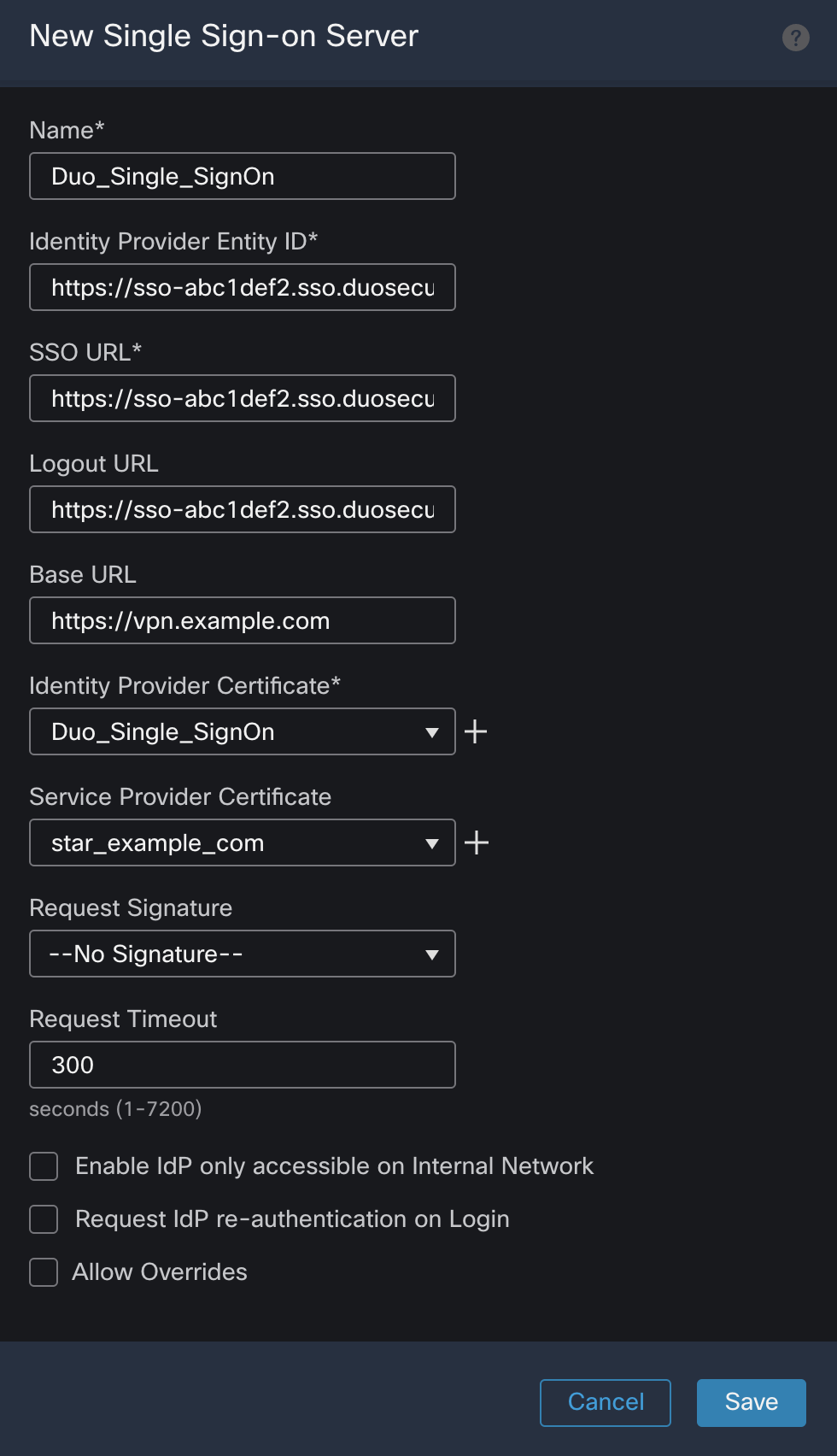
Assign SSO to a Connection Profile
-
On the Cisco FMC page click on the Devices button at the top of the page, from the drop-down click on Remote Access.
-
Click the pencil icon for the remote access configuration you'd like to update.
-
On the "Connection Profile" tab click the pencil icon for the connection profile you'd like to use SSO. A new window will pop-up.
-
On the "Edit Connection Profile" page click on the AAA tab.
-
Under "Authentication" select SAML from the Authentication Method drop-down.
-
Select Duo_Single_SignOn (SSO) or the name you used instead for your SSO server from the Authentication Server drop-down.
-
If you have more than one connection profile click the Aliases tab and make sure you have an "Alias Name" enabled for this connection profile.
-
Click Save. The window will close.
-
Click Save at the top-right hand side of the page.
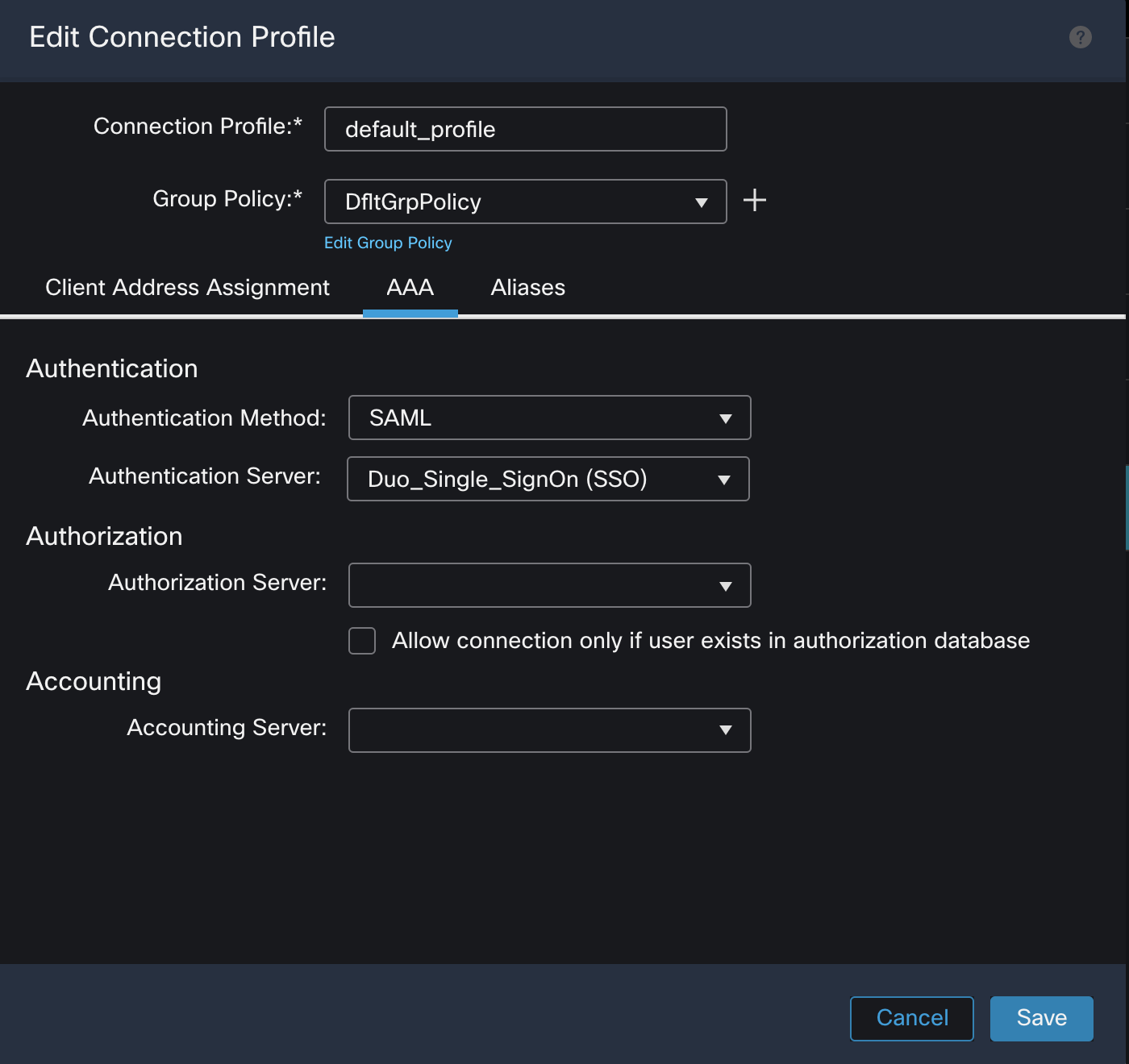
Learn more about Cisco Firepower SSO at Cisco Support.
Deploy Changes to the Firepower Device
-
On the Cisco FMC page click on the Deploy button at the top of the page, from the drop-down click on Deployment.
-
On the "Deployment" page check the box next to the FTD targeted for SSO. Click Deploy.
-
A pop-up will appear asking you to write deployment notes and then click Deploy.
-
The changes will take a few minutes to roll out and then you should see "Completed" under the "Status" section for that FTD device.
Update the Cisco Firepower Application in Duo
-
Return to the Duo Admin Panel with the Cisco Firepower application open. Find the Service Provider section.
-
Enter the base URL of your Cisco Firepower that you entered above as the Cisco Firepower Base URL. For example, if your Cisco Base base URL is https://vpn.example.com then enter vpn.example.com.
-
Enter the connection profile of your Cisco Firepower that you entered above as the Connection Profile Name. The connection profile name is case-sensitive and must match. For example, if your connection profile name is default_profile then enter default_profile.
-
Cisco Firepower uses the Mail attribute when authenticating. We've mapped the <Email Address> bridge attribute to Duo Single Sign-On supported authentication source attributes as follows:
Bridge Attribute Active Directory SAML IdP <Email Address> mail Email If you are using a non-standard email attribute for your authentication source, check the Custom attributes box and enter the name of the attribute you wish to use instead.
-
You can adjust additional settings for your new SAML application at this time — like changing the application's name from the default value, enabling self-service, or assigning a group policy.
-
Scroll to the bottom of the page and click the Save button.

Verify SSO
You can log into your Cisco Firepower using your organization’s login page e.g. https://vpn.example.com. Select the connection profile and click Logon. This redirects you to Duo Single Sign-On to begin authentication.
Active Directory Login
With Active Directory as the Duo SSO authentication source, enter the primary username (email address) on the Duo SSO login page and click or tap Next.
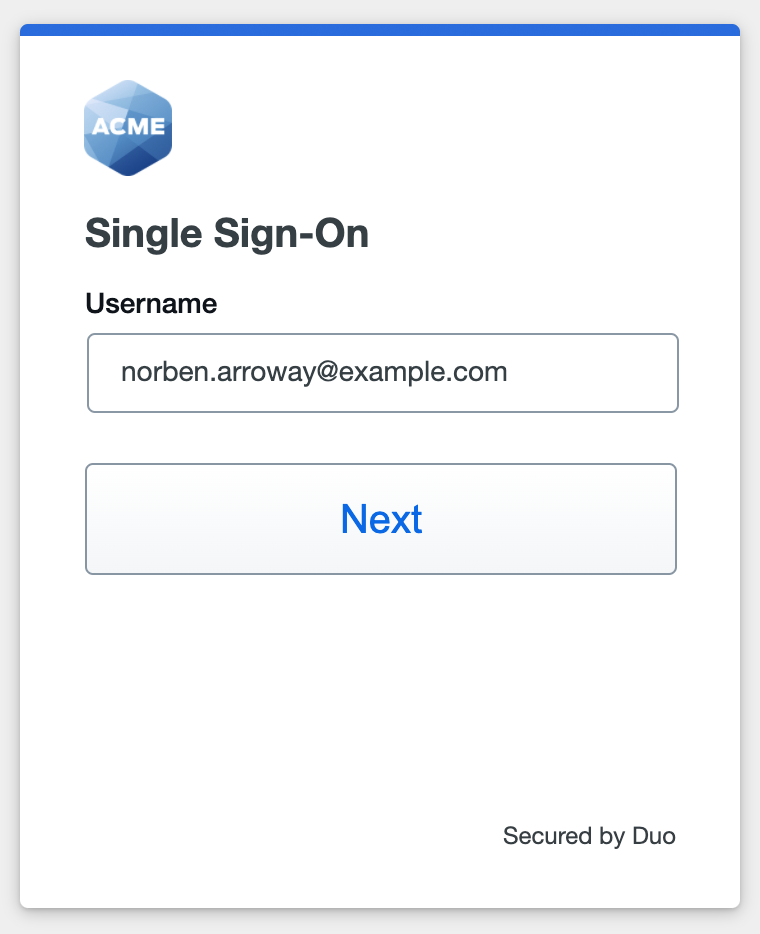
Enter the AD primary password and click or tap Log in to continue.
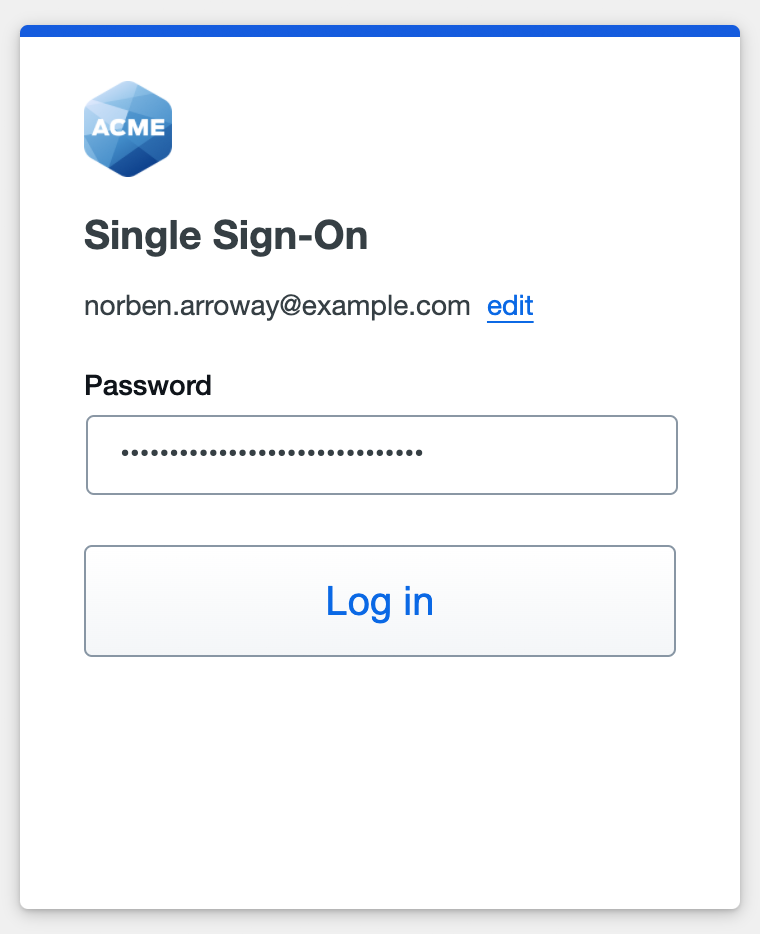
Enable Duo Passwordless to log in to Duo SSO backed by Active Directory authentication without entering a password in the future.
SAML Login
With another SAML identity provider as the Duo SSO authentication source, Duo SSO immediately redirects the login attempt to that SAML IdP for primary authentication. Users do not see the Duo SSO primary login screen.
Duo Authentication
Successful verification of your primary credentials by Active Directory or a SAML IdP redirects back to Duo. Complete Duo two-factor authentication when prompted and then you'll return to Cisco Firepower to complete the login process.

* Universal Prompt experience shown.
You can also log into Cisco Firepower using Duo Central, our cloud-hosted portal which allows users to access all of their applications in one spot. Link to Cisco Firepower in Duo Central by adding it as an application tile. Once the tile has been added, log into Duo Central and click the tile for IdP-initiated authentication to Cisco Firepower.
Cisco AnyConnect mobile or desktop apps require version 4.6 or higher. Select your connection profile from your client and click Login. You will be redirected to authenticate to Duo Single Sign-On.
Congratulations! Your Cisco Firepower users now authenticate using Duo Single Sign-On.
See the full user login experience, including expired password reset (available for Active Directory authentication sources) in the Duo End User Guide for SSO.
Grant Access to Users
If you did not already grant user access to the Duo users you want to use this application be sure to do that before inviting or requiring them to log in with Duo.
Enable Remembered Devices
To minimize additional Duo two-factor prompts when switching between Cisco Firepower and your other Duo Single Sign-On SAML applications, be sure to apply a shared "Remembered Devices" policy to your SAML applications.
Use of remembered devices with AnyConnect or Secure Client has the same deployment requirements as WebAuthn Support.
Troubleshooting
Need some help? Try searching our Knowledge Base articles or Community discussions. For further assistance, contact Support.
